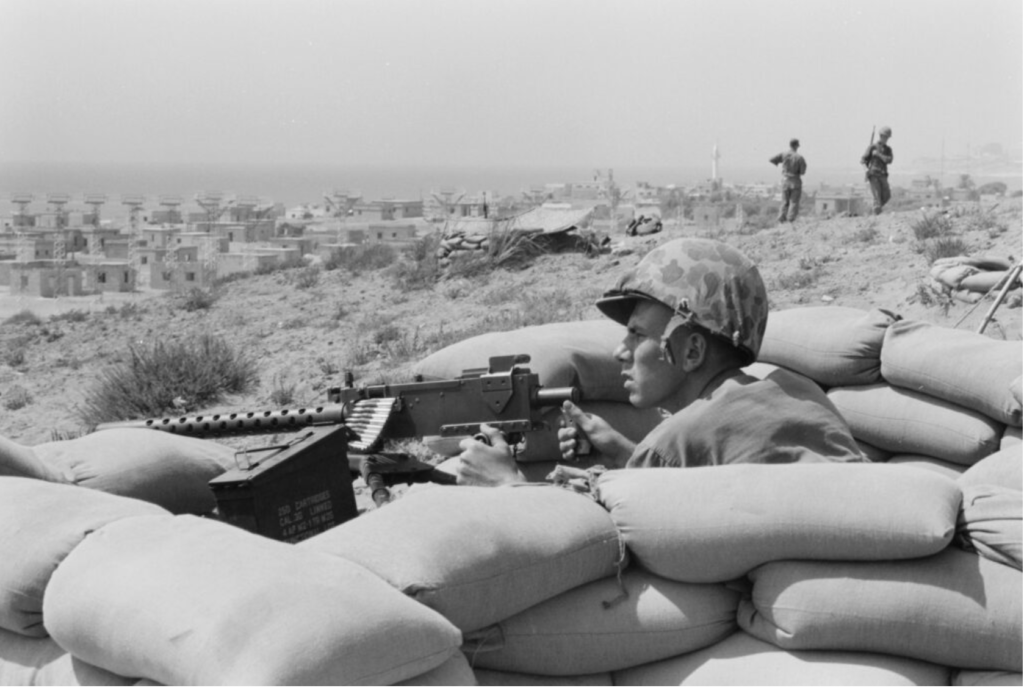1958 Lebanon: Cold War and Sectarian Unrest

By: Rania Basria | Arab America Contributing Writer
The 1958 Lebanon crisis was a watershed point in Middle Eastern history and Cold War politics as a whole. From May to October 1958, Lebanon was on the verge of civil war, torn between pro-Western and pro-Arab nationalist movements and highly affected by the worldwide conflict between the United States and the Soviet Union for regional supremacy. This article, written by Arab America contributing writer, Rania Basria, understands the scope of this crisis necessitates a thorough assessment of its underlying causes, the events that occurred, and the long-term consequences on Lebanon and the Middle East.
By the late 1950s, Lebanon’s distinctive political structure, which relied on a delicate balance of power among its numerous religious factions, was under severe strain. The National Pact of 1943 created a power-sharing pact between Christians and Muslims, to maintain a delicate balance in a country with a diverse religious landscape. However, demographic changes and divergent political objectives among these faiths exacerbated tensions. Christians, notably the Maronites, have generally supported Western interests, whilst many Muslims have been drawn to Arab nationalist ideas, particularly the Pan-Arabism advocated by Egyptian President Gamal Abdel Nasser.
The emergence of Arab nationalism and the establishment of the United Arab Republic (UAR) in 1958, a political union between Egypt and Syria, had far-reaching consequences for the region, including Lebanon. Many Lebanese Muslims embraced Nasser’s goal of a unified Arab world to gain political power and unity with their Arab brothers and sisters. This burgeoning Pan-Arab mentality contradicted the interests of Lebanon’s Christian population, who feared being sidelined in a mostly Muslim Arab world.
On May 8, 1958, Nassib Metni, a renowned Lebanese journalist and critic of President Camille Chamoun, was assassinated, causing the conflict to escalate. Metni’s murder sparked significant protests and rioting, notably in Beirut and Tripoli, as opposition parties accused Chamoun of attempting to prolong his presidential term beyond the constitutional limit. The opposition, which included diverse Muslim groupings and Marxist organizations, viewed Chamoun’s pro-Western stance and strong links to the United States with distrust and animosity.
Chamoun’s plea for US action aggravated the situation and highlighted Lebanon’s fundamental differences. Fearing that the crisis would escalate into a full-fledged civil war, potentially involving foreign powers such as Egypt and Syria, Chamoun requested military assistance from the United States under the Eisenhower Doctrine, which guaranteed US support to any Middle Eastern country threatened by communism. In response, on July 15, 1958, the United States launched Operation Blue Bat, sending around 14,000 troops to Lebanon. The action was intended to calm the situation, safeguard American lives, and strengthen the pro-Western administration.
The presence of US forces, while first contentious, later helped to restore peace. The US soldiers avoided direct engagement in the internal struggle, and instead focused on protecting important locations and acting as a buffer between the competing groups. This careful approach contributed to the de-escalation of tensions and the creation of an environment conducive to political settlement.
In October 1958, a political agreement was found with the election of General Fuad Chehab as President. Chehab, a renowned politician with widespread support across Lebanon’s sectarian lines, was viewed as a uniting candidate capable of directing the nation toward stability. His administration heralded a period of relative stability and change known as the Chehabist era, which included initiatives to modernize the state, develop infrastructure, and address socioeconomic inequities.
However, sectarian tensions remained unsolved. The 1958 Lebanon crisis was a watershed moment that exposed the fragility of Lebanon’s political system as well as the heavy pressures placed by regional and international powers. It highlighted the intricacies of Lebanese identity, which is stuck between opposing nationalistic ideologies and other pressures.
The situation had larger ramifications for the Middle East. It highlighted the United States’ determination to act militarily in the area to safeguard its interests and back its friends, paving the way for future American participation in Middle Eastern issues. For Arab nationalists, the crisis and subsequent US intervention highlighted the difficulties they faced in establishing greater unity and independence in a region dominated by foreign powers.
In the years that followed, Lebanon grappled with internal differences as well as regional and international political forces. The relative peace of the Chehabist era gave way to increased violence in the 1970s and 1980s, culminating in the 1975–1990 Lebanese Civil War. The consequences of the 1958 crisis, such as sectarian tensions and the presence of foreign powers, were essential to Lebanon’s ongoing battles.
In conclusion, the 1958 Lebanon crisis was a crucial and complicated event in Middle Eastern history. It was fueled by long-standing sectarian tensions, regional political currents, and Cold War dynamics. While the crisis was ended by political compromise and international assistance, it had a long-term influence on Lebanon, emphasizing the difficulties of sustaining a heterogeneous democracy in a volatile area. The lessons of 1958 continue to reverberate throughout Lebanon and the wider Middle East, highlighting the complex interplay of internal and foreign influences that shape the region’s history.
Check out our Blog here!








